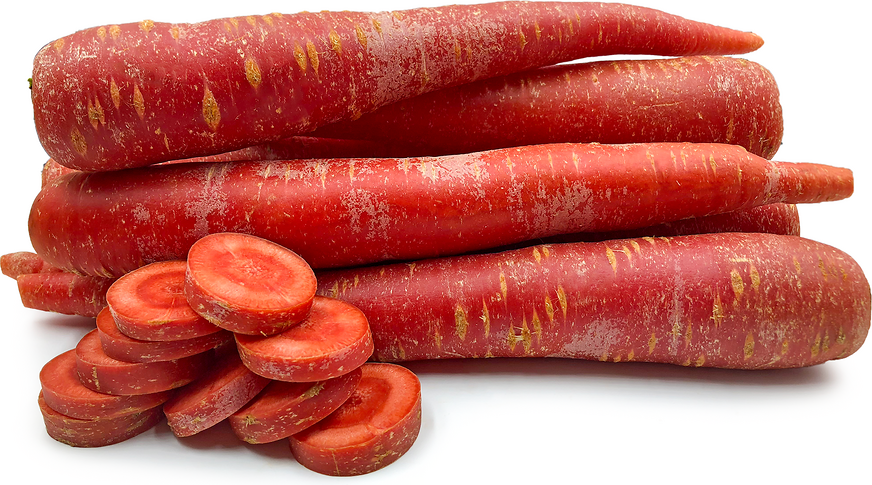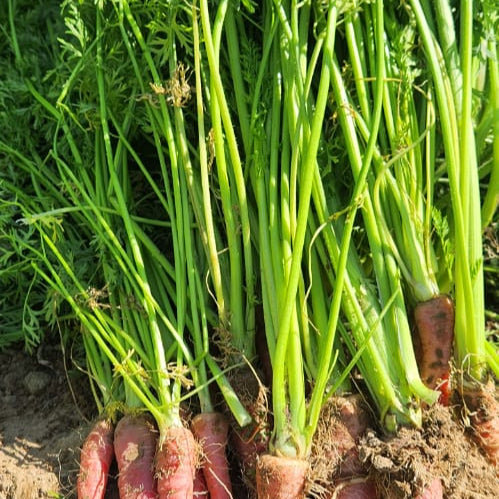





Carrot Red Seeds
Grow this with
Seed Type : Non-Hybrid, Open Pollinated and Non-GMO
Sowing time : August to October sowing
Roots : Exceptionally sleek, tender and tapering, 10-12 inches long and dark red in colour,very attractive shape and size.
Specifications : 100 % red core, sweet
Maturity : 75-80 days after sowing.
- SOWING
TIMEAug - Oct
- Sowing
DistanceSeed to seed - 2"
Line to line - 1.5' - Fruit
WeightN/A
- Fruit
Shapelong and tapering
- Days to
maturity75-80 days
- Details
- How to sow
- Reviews
The luscious red carrots, are at their glorious best during the fall months, i.e. from November to February. Carrots, also known as Gaajar in some South Asian countries including India, also come in black, purple, white, and yellow varieties apart from the easily available and widely consumed orange and red ones. If you are protective about your eyesight and want to restore it in the long-run, then carrots is what you should be eating more often. Including it in your daily diet also helps in regulating blood sugar levels, preventing the risk of brain stroke while also giving a boost to immunity.
Carrots make for a great mid-meal snack too. Simply pick a carefully washed and peeled one and munch on the fresh goodness. Even for salads you can play around a bit and experiment with interesting shapes. You can grate, shred, julienne, or slice them in sticks or roundels. Even if you want to cook them, make sure not to expose them to heat for longer periods as it will considerably reduce the benefits of beta-carotene and other antioxidants.
Planting instructions
Plan to plant seeds outdoors as the weather starts to cool down but before the onset of winters.
Plant seeds ½ inch deep.After germination thin carrot seedlings (when they’re 2-3 inches tall) to about 2 – 3 inches apart.
For potting, choose 10-inch deep and as wide as possible containers.
Choose a location that is sunny.
Growing Requirements
watering
Water regularly and evenly to keep the soil slightly moist and never allow the soil to dry out completely.Avoid waterlogging the pots.
pests
Weeds, pests, and diseases effect the growth of carrots on the ground but rarely in containers. Carrot flies fly close to the ground and can be prevented by creating barriers or lifting the container off the ground. Aphids (plant lice) and flea beetles are common pests that can disturb the foliage growth but can be easily controlled by natural ways.
soil
The ideal soil is deep,sandy and well-drained so that the carrots can push through and are not forked or send out small side roots.Ideal pH range from 6 to 7. If you want to make a soilless mix, add 1 part coco peat,1 part well-rotted manure, and 1 part vermicompost or sand.
spot
To encourage root growth,use a fertilizer that is low in nitrogen but high in phosphorous and potassium
temperature
Carrots best germinate and grow when the temperature is between (15 – 25 C). Carrot seeds usually germinate in the time-frame of 1-3 weeks.If you’re growing carrots in pots, you can try to adjust the temperature a bit by moving the containers to shade if the weather is warm and in more sun if the weather is too cold.
how to harvest
Harvesting time may vary from 60 – 110 days depending on the carrot type, climate and growing conditions. Before picking, see whether your carrots have reached the desired size or not by uprooting a couple of plants.
You may leave mature carrots in the soil for few extra days for storage if the soil does not get block.
To store freshly harvested carrots, twist off the tops, scrub off the dirt under cold running water, let dry and seal in airtight plastic bags, and refrigerate.

Customer Reviews
The productiveness of any seed we sell is subject to your local climatic conditions*, the sowing method you adopt, and your commitment to the planting process. We give no warranty, expressed or implied, and are in no way responsible for the produce.
Please note that all our seasonal recommendations/ sowing information is as per the local climatic conditions. *For more information on the optimum conditions required for growing seeds in your region, please contact us at, hello@allthatgrows.in or Whatsapp us at, +91 8544865077
Questions & Answers
Have a Question?
Be the first to ask a question about this.






Carrot Red Seeds
Seed Type : Non-Hybrid, Open Pollinated and Non-GMO
Sowing time : August to October sowing
Roots : Exceptionally sleek, tender and tapering, 10-12 inches long and dark red in colour,very attractive shape and size.
Specifications : 100 % red core, sweet
Maturity : 75-80 days after sowing.
Grow this with
The luscious red carrots, are at their glorious best during the fall months, i.e. from November to February. Carrots, also known as Gaajar in some South Asian countries including India, also come in black, purple, white, and yellow varieties apart from the easily available and widely consumed orange and red ones. If you are protective about your eyesight and want to restore it in the long-run, then carrots is what you should be eating more often. Including it in your daily diet also helps in regulating blood sugar levels, preventing the risk of brain stroke while also giving a boost to immunity.
Carrots make for a great mid-meal snack too. Simply pick a carefully washed and peeled one and munch on the fresh goodness. Even for salads you can play around a bit and experiment with interesting shapes. You can grate, shred, julienne, or slice them in sticks or roundels. Even if you want to cook them, make sure not to expose them to heat for longer periods as it will considerably reduce the benefits of beta-carotene and other antioxidants.
Seed Type : Non-Hybrid, Open Pollinated and Non-GMO
Sowing time : August to October sowing
Roots : Exceptionally sleek, tender and tapering, 10-12 inches long and dark red in colour,very attractive shape and size.
Specifications : 100 % red core, sweet
Maturity : 75-80 days after sowing.
- SOWING
TIMEAug - Oct
- Sowing
DistanceSeed to seed - 2"
Line to line - 1.5' - Fruit
WeightN/A
- Fruit
Shapelong and tapering
- Days to
maturity75-80 days
Planting instructions
Plan to plant seeds outdoors as the weather starts to cool down but before the onset of winters.
Plant seeds ½ inch deep.After germination thin carrot seedlings (when they’re 2-3 inches tall) to about 2 – 3 inches apart.
For potting, choose 10-inch deep and as wide as possible containers.
Choose a location that is sunny.
Growing Requirements
watering
Water regularly and evenly to keep the soil slightly moist and never allow the soil to dry out completely.Avoid waterlogging the pots.
pests
Weeds, pests, and diseases effect the growth of carrots on the ground but rarely in containers. Carrot flies fly close to the ground and can be prevented by creating barriers or lifting the container off the ground. Aphids (plant lice) and flea beetles are common pests that can disturb the foliage growth but can be easily controlled by natural ways.
soil
The ideal soil is deep,sandy and well-drained so that the carrots can push through and are not forked or send out small side roots.Ideal pH range from 6 to 7. If you want to make a soilless mix, add 1 part coco peat,1 part well-rotted manure, and 1 part vermicompost or sand.
spot
To encourage root growth,use a fertilizer that is low in nitrogen but high in phosphorous and potassium
temperature
Carrots best germinate and grow when the temperature is between (15 – 25 C). Carrot seeds usually germinate in the time-frame of 1-3 weeks.If you’re growing carrots in pots, you can try to adjust the temperature a bit by moving the containers to shade if the weather is warm and in more sun if the weather is too cold.
how to harvest
Harvesting time may vary from 60 – 110 days depending on the carrot type, climate and growing conditions. Before picking, see whether your carrots have reached the desired size or not by uprooting a couple of plants.
You may leave mature carrots in the soil for few extra days for storage if the soil does not get block.
To store freshly harvested carrots, twist off the tops, scrub off the dirt under cold running water, let dry and seal in airtight plastic bags, and refrigerate.



 Sign In
Sign In








